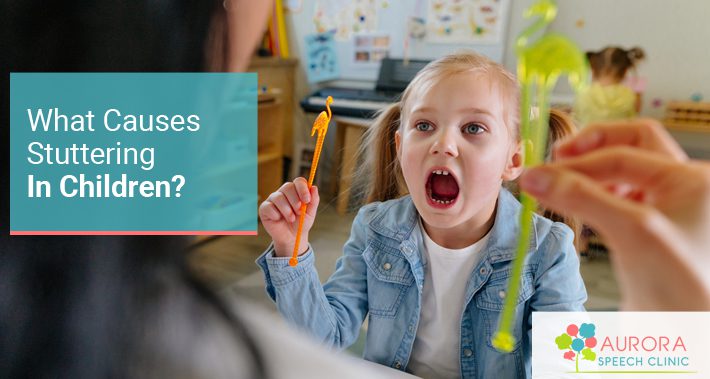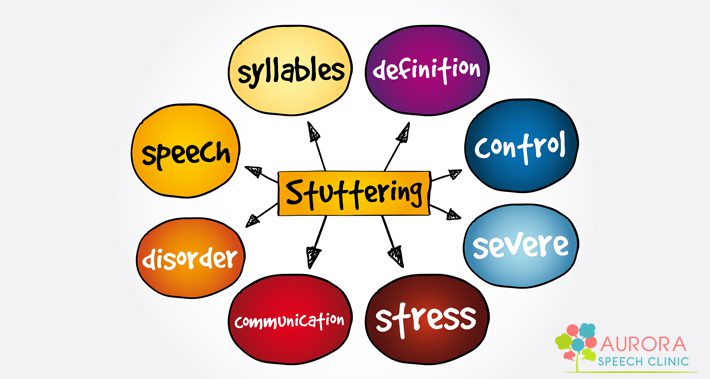
When many people think of speech therapy, stuttering might be the first thing that comes to mind.
While speech-language pathologists (SLPs) provide assessment and treatment for a wide variety of different speech, language, and swallowing disorders, stuttering is amongst the most common type of communication disorder.
In fact, it’s estimated that 4% of Canadian children stutter.
It’s common in the United States as well – approximately 3 million Americans stutter.
At Aurora Speech Clinic, our pediatric speech-language pathologists are trained in the assessment and treatment of stuttering disorders in children.
Exploring the various factors related to childhood stuttering is important for devising effective intervention strategies.
Today, we’ll explore the root causes of stuttering in children, and how speech therapy can help.
What Is The Definition Of Stuttering?
Stuttering is the most common type of fluency disorder and it refers to speech that is characterized by specific types of disfluencies such as:
RELATED: Speech Therapy For Fluency Disorders
Repetitions of sounds, syllables, or words (e.g., “I like Se-se-se-se-sesame Street”)
Prolongations, where sounds are stretched out (e.g., “I like Ssssssssssssesame Street”)
Blocked speech, which presents as long pauses (e.g., “I like…………..Sesame Street”)
The above disfluencies may also be accompanied by secondary characteristics (e.g., blinking, head movement, vocal tension)and avoidance behaviours.
That said, it is important to note that occasionally stumbling over your words is very common and not cause for concern.
Your child may also become disfluent, at times, as they learn to talk. The following types of disfluencies are considered “typical disfluencies” and can be a completely normal part of speech and language acquisition in some children.
Your child’s disfluency is less likely to continue if:
- It is characterized by repeating phrases, versus the patterns outlined above (e.g,. “I like, I like Sesame Street”) or using filler words (e.g., “um…but…”)
- There is no tension, physical struggle, or other accompanying behaviours when speaking
- No family history of stuttering
- Speech has been disfluent for less than 6 months
If you are unsure if your child’s disfluencies are more characteristic of true stuttering or “typical disfluency” it’s best to err on the side of caution and seek out an assessment, either in person or through speech teletherapy.
As with most communication delays or disorders, early intervention leads to best outcomes.
A meta-analysis of studies shows that early intervention is more than seven times more effective than treatment later on.
So instead of the “wait and see” approach, we suggest “well, let’s see.”
What Causes A Child To Stutter?
Like many speech and language disorders, there isn’t a single root cause of stuttering we can identify.
Further, most cases of stuttering are considered idiopathic. (i.e. there’s no immediately identifiable cause).
Research is ongoing into better understanding this speech disorder.
However, there are a number of different factors we know that can contribute to the development of a stutter.
Let’s take a closer look.
1. Genetics
Research suggests a genetic component to stuttering, with studies indicating a higher likelihood of stuttering among individuals with a family history of the disorder.
We also know that identical twins usually have more similar stuttering patterns than fraternal twins do.
Despite this, we haven’t yet discovered a “stuttering gene.”
However, it’s thought that certain genetic factors may influence neural pathways associated with speech production and motor control.
This contributes to the development of stuttering in children.
We also know boys and children assigned male at birth are more likely to stutter, though the reason why isn’t yet understood.
2. Neurological Factors
Neurological studies have identified differences in brain structure and function among individuals who stutter.
In particular, people who stutter have more brain activity in the brain’s right hemisphere, and less in the left hemisphere.
Neuroanatomy is a very complex field we’re just beginning to understand, but broadly speaking, the left hemisphere controls things like speaking, writing, and math.
Meanwhile, the right hemisphere controls creative skills like art and music.
Interestingly, this may be one of the reasons why people who stutter while speaking may be able to sing without doing so.

3. Environmental Influences
Environmental factors can influence your child’s speech development as well.
This can include familial dynamics, social interactions, and stressors.
It’s important to note that these things, on their own, do not cause stuttering.
If your child has a stutter, it’s not your fault.
However, certain conditions may exacerbate stuttering symptoms that are already present.
Fostering a nurturing, loving environment may help to manage their symptoms.
This can include things like:
- Creating a sensory friendly environment
- Not getting upset at picky eating habits
- Reading with your child to help build their vocabulary
- Understanding how to approach neurodiversity-affirming parenting
RELATED: Speech Therapy For Autistic Children
RELATED: Teaching Your Child To Read
Most importantly, however, it’s critical to avoid expressing frustration or impatience as your child stutters.
4. Speech Motor Skills
Speech production involves complex coordination of various muscle groups.
Disruptions in speech motor control mechanisms may contribute to stuttering.
Children with stuttering difficulties may exhibit differences in motor planning and execution, leading to hesitations or repetitions during speech.
Speech therapy techniques targeting motor control and coordination can aid in enhancing speech fluency and articulation.
5. Common Comorbidities With Stuttering
We know there are a number of communication disorders that occur more commonly with stuttering than with the population at large.
In fact, a 2002 study estimates that 62.8% of children who stutter have at least one other disorder.
The most common are speech sound disorders, which include articulation disorders and phonological disorders.
For example, children who are neurodivergent have a higher likelihood of stuttering than neurotypical kids.
The neurodivergent population includes autistic people, as well as those with ADHD, executive function deficits, and sensory processing disorder.
Other comorbidities may include:
- Voice disorders
- Cluttering (another type of fluency disorder)
- Expressive and/or receptive language disorders
- Literacy disorders
- Other learning disabilities
They may also have a disorder not related to speech-language pathology, like central auditory processing disorder or a behavioural disorder.
Kids who stutter are also more likely to experience an anxiety disorder.
It’s not yet understood, though, whether this is a cause of a stuttering disorder, or if stuttering creates anxiety around speaking.
Book Your Appointment With Aurora Speech Clinic Today
If you have questions or concerns about your child’s fluency, consult a licensed speech-language pathologist.
Here at Aurora Speech Clinic, our team of therapists includes SLPs and occupational therapists with a wide variety of areas of clinical focus.
That includes stuttering, and the other accompanying speech or language delays or disorders.
Book your appointment with Aurora Speech Clinic today.
372 Hollandview Trail, #302,
Aurora, ON L4G 0A5
(905) 503-4321
» https://goo.gl/maps/fg3XKnNsczzwLzTz7
Aurora Speech Clinic is located in Aurora, ON and offers personalized skilled intervention to those struggling with their speech and language skills. Services offered include screening, consultation, and comprehensive evaluation. We also provide one-on-one and/or group therapy for speech sound disorders, receptive/expressive language delay/disorder, stuttering/cluttering, accent reduction, and much more.